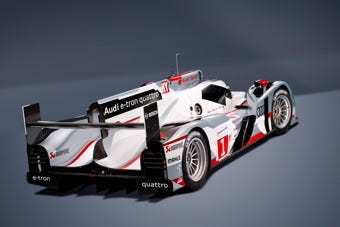Audi's success with diesel hybrid sports cars at the 24-hour Le Mans race this year was due in part to keeping an eye on competitors running behind it despite the car having no rear window.The high-tech solution employed at Le Mans, and soon to be used in the high-performance Audi R8 e-tron debuting at the end of this year, is an intelligent camera/monitor system dubbed the "digital rear-view mirror."
August 13, 2012
Audi's success with diesel hybrid sports cars at the 24-hour Le Mans race this year was due in part to keeping an eye on competitors running behind it despite the car having no rear window.
The high-tech solution employed at Le Mans, and soon to be used in the high-performance Audi R8 e-tron debuting at the end of this year, is an intelligent camera/monitor system dubbed the "digital rear-view mirror."
|
Digital rear-view mirror display was developed through Audi's racing program and used in the Audi R18 e-tron quattro Diesel Hybrid race winner. |
|
Digital mirror displays image from tiny rear-facing lens. |
The small, ultra-lightweight camera that delivers the images is located in an aerodynamically optimized housing (which is heated in cold temperatures). It uses a lens with a diameter of just a few millimeters and covers a much larger field of vision than a conventional rear-view mirror.
A color monitor with a 7.7-inch screen mounted in place of the conventional rear-view mirror is used to display the digital image data from the camera. This AMOLED (Active Matrix Organic Light Emitting Diode) display, sourced from development partner Samsung Display Co., is making its debut in a passenger car. The organic materials used in the display are self-illuminating at a low voltage—i.e. they do not require backlighting. AMOLED technology has already proved widely successful in cell phones and similar devices in the consumer segment.
A control unit ensures a consistent high-contrast, brilliant image from the display. During the hours of darkness the intelligent control system prevents dazzle from the headlights of other vehicles. The driver can dim or deactivate the display at any time. Audi is also working on incorporating additional information on the monitor in future.
The new displays are more energy efficient, thinner, and lighter than conventional LCD monitors. Switching times are just a few milliseconds irrespective of the ambient temperature.
The digital rear-view mirror celebrated its dazzling premiere at the Le Mans 24 Hours in the R18 e-tron quattro and R18 ultra race cars which gave Audi a one-two-three win in the legendary race. The new system proved reliable even under the grueling race conditions. —[email protected]
About the Author(s)
You May Also Like




